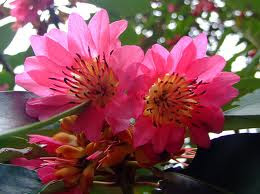A pleading word about the selection at the Georgia Green Industry's 2012 Trade Show
 |
| Photo from a Chinese website that I couldn't identify; The light at the Gwinnett Ctr. was terrible for pics. |
So, I tell you to read this with a grain of salt for fairness' sake. Indeed, I did see some people with whom I enjoyed reconnecting, and perused some lovely plants, including a dreamy Rhodoleia henryi grown by Ted Steven's at Nurseries Caroliniana--it's a Lorapetalum relative in the Witchhazel family that has big Camellia/ Daphniphyllum-like leaves and a blousy pinkish-red flower that could be a cross among the flowers of an Illicium, a Camellia, a Fuschia, and a Christmas Cactus.
So here's where my complaining comes in: I'm frustrated that the evervated economy continues to drive decisions that in turn hurt the economy further: I didn't see many special plants, which is concerning at a trade show as nurseries are usually trying to showcase their best (with some exceptions of course, like the standout conifers from Topiary Courtyard, a great Dyckia, some Agaves, and an elegant Strobilanthes from Grandiflora, an amazing dwarf Metasequoia at Goodness Grows, grasses and forbs from Baker Environmental, to name a few). And among the special plants I did see, I doubt they will ever be available for me to purchase, because the growers aren't doing them in any viable quantities. In talking to Debra Green of Green Nurseries about having difficulty finding Abies firma--an Abies well suited for the South--she said they're going to have have stop growing them and do more bread and butter plants because of the "hurting economy." David pointed out that their doing more bread and butter hurts our economy, because being designers who are also passionate about plants requires that we have a broad palette of plants that thrive in our area--not just the obvious landscapey plants. Although I might have no qualms about $15-$30 on a select mail order perennial that looks worse than a starving street urchin for my own gardening, I can't do that for a client. The business side of garden design requires plants that make an impact in a new design. But the business side can't only rely on big boring Leylands.
There is a bad cycle that results when we're in a slump: designers don't purchase large quantities of cool plants because we're not getting projects that allow for them; thus, we can't order them from the nurseries, nurseries stop growing them, and consequently we don't see them available even when we do have projects and the economy is picking up. This in turn makes the work we do less exciting and distinctive, and therefore harder for us to win good projects. The nurseries then get bad data about the plants people are willing to buy, as they have so narrowed the universe of possibilities and won't risk branching that they stop testing the market. I understand that the nursery business is a hard one--very hard--and that it's been especially tough in GA due to the drought that knocked us over a couple of years before the economy bottomed. But we're ready to grow interesting plants that really thrive here for us! Not just another variety of Hydrangea macrophylla. And not just another Otto Leucan Laurel look-alike. Take a risk nurseries, and we will do our best to patron you!



Comments
Post a Comment